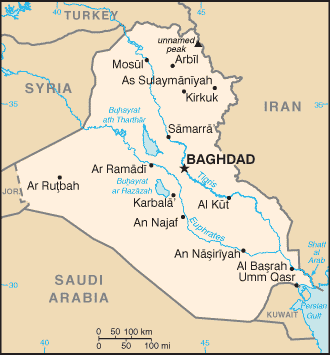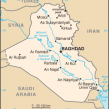Iraq’s Islamic Mujahideen Profiled by Jihadi Websites: Part Two
Publication: Terrorism Focus Volume: 5 Issue: 41
By:

In the last issue of Terrorism Focus, we examined the profiles of three Iraqi jihadi groups based on information compiled by al-Haq, an Islamic news website and later distributed through a number of jihadi internet forums (haqnews.net August 7, 2008). This issue will cover four remaining major insurgent groups mentioned in al-Haq’s research.
Al-Qaeda in Mesopotamia (AQM)
This group (also known as al-Qaeda in Iraq) began insurgency operations in Iraq immediately after the occupation, under the name Jama’at al-Tawhid wa’l-Jihad (Monotheism and Jihad Group). In October, 2004, the late leader of the group, Abu Musab al-Zarqawi, pledged allegiance to al-Qaeda’s leader Osama Bin Laden and changed the name of the group to al-Qaeda in Mesopotamia. Zarqawi also joined the shura council of the mujahideen in Iraq. Al-Qaeda in Mesopotamia later became the core of the so-called Islamic State of Iraq (ISI).
The objectives of AQM are not limited to the liberation of Iraq. Similar to al-Qaeda’s global stance, AQM aims to wage international jihad against the United States and its Arab allies and to establish a pan-Islamic Caliphate.
- Ideology
AQM is a Salafi-Jihadi extremist group. “We believe the umma (Islamic nation) must come under one flag, especially that of the mujahideen,” which is what the group tried to accomplish with the declaration of the Islamic State of Iraq (al-Furqan, October 15, 2006). The reluctance of other resistance movements to come under the umbrella of al-Qaeda leadership consequently led to confrontations between AQM and almost all other jihadi groups. The 1920 Revolutionary Brigades and al-Jaysh al-Islami fi’l Iraq (The Islamic Army in Iraq) became AQM’s arch foes (see Terrorism Focus, November 25). AQM not only rejects the political process in Iraq, it targets all Iraqi parties that joined the process, including the Sunni entities. Any dealing with the occupiers is deemed blasphemy and apostasy, therefore AQM attacks the Iraqi government and its military, intelligence units and police without any exception. No party or individual is spared by AQM unless they pledge allegiance to the ISI. Internationally, AQM considers Muslim countries “infidels,” stating; “We believe if infidel legislations prevails in a country and the dominance is for infidel rulers as opposed to Islamic rule, the country is infidel. All forums of secularism, such as nationalism, socialism, communism and Ba’athism are stark blasphemy” (al-Furqan, October 15, 2006).
- Military activities
In the beginning, the military activities of AQM concentrated in the western areas of Iraq such as al-Anbar. After the second battle for Fallujah in October, 2004, the group spread through the Sunni governorates, central Iraq and a few areas in southern Iraq. The group is notorious for suicide attacks using vehicles filled with explosives, assassinations and the direct engagement of enemy forces.
Among AQM’s most notorious attacks are the bombing of the Jordanian Embassy in Baghdad in August 2003; the bombing of UN headquarters in Baghdad on August 19, 2003; the Najaf bombings on August 29, 2003, that killed Shiite leader Muhammad Baqir al-Hakim; the bombing of the Italian military headquarters in al-Nasiria on October 12, 2003; the Amman hotel bombing of November 9, 2005; and the September, 2007 assassination of the head of al-Anbar’s Awakening council, Shaykh Abdul Sattar Abu Risha. AQM also kidnapped and killed American Nicholas Berg, four Egyptian diplomats, one Algerian diplomat and two local staff from the Moroccan Embassy in Baghdad. AQM also formed the Omar Legion to confront the Shiite Badr Brigades.
- Media activities
AQM activities enjoy extensive coverage from almost all major news channels. The video and audio messages of group leaders are monitored and broadcast all over the world. Al-Furqan, the ISI media agency, continuously releases video clips of attacks perpetrated by AQM under names such as “From the Mujahideen Harvest” and “American Intelligence in Baghdad’s Streets.” Audio lectures on religious topics by AQM leaders are also released on the internet. The group publishes regular magazines called Tharwat Sinam al-Jihad and Nashrat al-Marsad. Al-Furqan and al-Fajr are AQM’s media agencies, though they make use of many jihadi websites and forums such as al-hesbah.info, al-firdaws.info, al-ekhlaas.net, muslm.net, and m3ark.net, just to name a few.
Islamic Front for Iraqi Resistance (JAAMI) / Salah al-Din Brigades (SDB)
JAAMI (al-Jabha al-Islamiya li’l Moqawama al-Iraqiya) was proclaimed on April 28, 2004, as a political party with the Salah al-Din Brigades as its military wing. Lately the group has joined a jihadi front with Iraqi Hamas.
- Ideology
JAAMI is a moderate Islamic jihadi group affiliated with the Muslim Brothers of Iraq. Although the group doesn’t recognize the Iraqi government and rejects the political process in Iraq, it shows flexibility in dealing with political developments.
- Military activities
SDB operates mainly in the Sunni governorates and has about twenty small formations launching rocket and mortar attacks on Coalition bases. Although the group aims to expel the occupiers from Iraq by military means, the official spokesman of the group, Dr. Saif al-Din Mahmoud, renounced the use of booby-trapped vehicles in cities, suicide bombings, abducting and killing hostages and attacks on civilians in a 2005 communiqué. SDB cooperates with all Iraqi jihadi groups except al-Qaeda. The group refused an al-Qaeda ultimatum to hand over its weapons.
- Media activities
Videotapes of the group’s operations are released over the internet. Printed communiqués and political statements are distributed on the streets, in mosques and posted in public places. Electronically, the group posts its publications on its official website (jaami.info) along with jihadi forums such as hanein.info, alboraq.info and hisbah.net
Mujahideen Army (MA)
The Mujahideen Army is an Islamist group believed to be associated with al-Jaysh al-Islami fi’l Iraq. According to official MA spokesman Abdul Rahman al-Qaisi, the group was founded before the occupation of Iraq, operating as a relief agency helping students and preaching Islam in mosques. Although the first objective of MA is to liberate Iraq by waging “defensive jihad,” MA considers implementing Islamic Sharia after liberation a long term strategic goal rather than an immediate objective (like most other Iraqi groups).
Spokesman Abdul Rahman al-Qaisi has appeared in news programs and documentaries on a few Arabic news channels, but MA’s video clips of insurgency operations are mostly released through the internet. The group doesn’t have any regular publications other than political and military communiqués uploaded to the group’s websites (al-tamkeen.com, tamkeen.iraqserve.com). MA also uses other jihadi forums for propaganda, such as al-hisbeh.info, alboraq.info and muslm.net.
Al-Rashidin Army (RA)
The existence of this Sunni Islamist group was made public in 2005, but the RA carried out its first attack on Coalition forces in April 2003, according to RA spokesman Adil al-Zahawi. RA operates in concordance with 1920 Revolutionary Brigades policies and objectives. The group legitimizes the killing of occupation forces, collaborators and anyone having a political or military affiliation with the occupiers. RA rejects the political process in Iraq, doesn’t recognize the Iraqi constitution or government and aims to set up a just and democratic government after the withdrawal of U.S. forces.
- Military Activities
RA is composed of different battalions, such as al-Kawthar, al-Firdaws, Junud al-Rahman, al-Fajr al-Sadiq and the Muslim Bin Aqil battalion, among others. RA battalions operate in the Sunni areas of Iraq and Baghdad. The group uses rockets, mortars, roadside bombs and snipers in its attacks.
- Media Activities
The group’s insurgency video clips have appeared on al-Zawra and al-Rafidayn T.V channels. Other statements and communiqués are posted in RA’s websites (alrashedeenarmy.com; al-rashedeen.info).
The United Fronts
Almost all Iraqi insurgency groups have attempted to unite under one common front against the occupation – so far the process has yielded a number of different fronts and sub-fronts, with the membership as given by al-Haq below:
Islamic State of Iraq
– Mujahidin Shura Council – The council is made up of al-Qaeda in Mesopotamia, al-Taifa al-Mansoura Army, Saraya al-Jihad al-Islami, al-Ahwal Brigades, Saraya Ansar al-Tawhid and Saraya al-Ghoraba.
– Jamaat Jund al-Sahaba
– Saraya Fursan al-Tawhid
– Saraya Milat Ibrahim
– Kurdistan Brigades
– Ansar al-Tawhid Wa al-Sunna Brigades
The Political Council for Iraqi Resistance
– Jihad and Reform Front made up of al-Jaysh al-Islami fi’l Iraq, the Mujahideen Army, Jama’at Ansar al-Sunna, Jaysh al-Fatiheen
– Hamas of Iraq
– Islamic front for Iraqi Resistance
Jihad and Change Front
– 1920 Revolutionary Brigades
– Al-Rashidin Army
– Jaysh al-Muslimin fi’l Iraq
– Islamic movement of Iraqi Mujahideen
– Saraya Jund al-Rahman
– Saraya al-Dawa wa’l-Ribat
– Al-Tamkeen Brigades
– Muhammad al-Fatah Brigades
Jihad and Liberation Front
– Jaysh al- Naqshabandi
– Jaysh al-Sahaba
– Jaysh al-Morabitin
– Jaysh Hamza
– Jaysh al-Risala
– Jaysh Ibn al-Waleed
– United Mujahideen Leadership
– Al-Tahrir brigades
– Jaysh Tahrir al-Iraq
– Saraya al-Shohada
– Jaysh al-Sabirin
– Jihad Ala Ard al-Rafidayn brigades
– Jaysh al-Faris
– Saraya al-Jihad fi’l Basra
– Saraya al-Fallujah
– Popular National Front for the Liberation of Iraq
– Saraya Altaf al-Husseinia Revolution
– Saraya Tahrir al-Janub
– Jaysh Hanein
– Saraya Diyala for Jihad and Tahrir
– Saraya al-Majd for Liberation of Iraq
There are over twenty-five more small and mostly unknown groups mentioned in al-Haq’s study that have not been mentioned in the media, nor have they been known to perpetrate significant attacks on U.S. or Iraqi forces.





